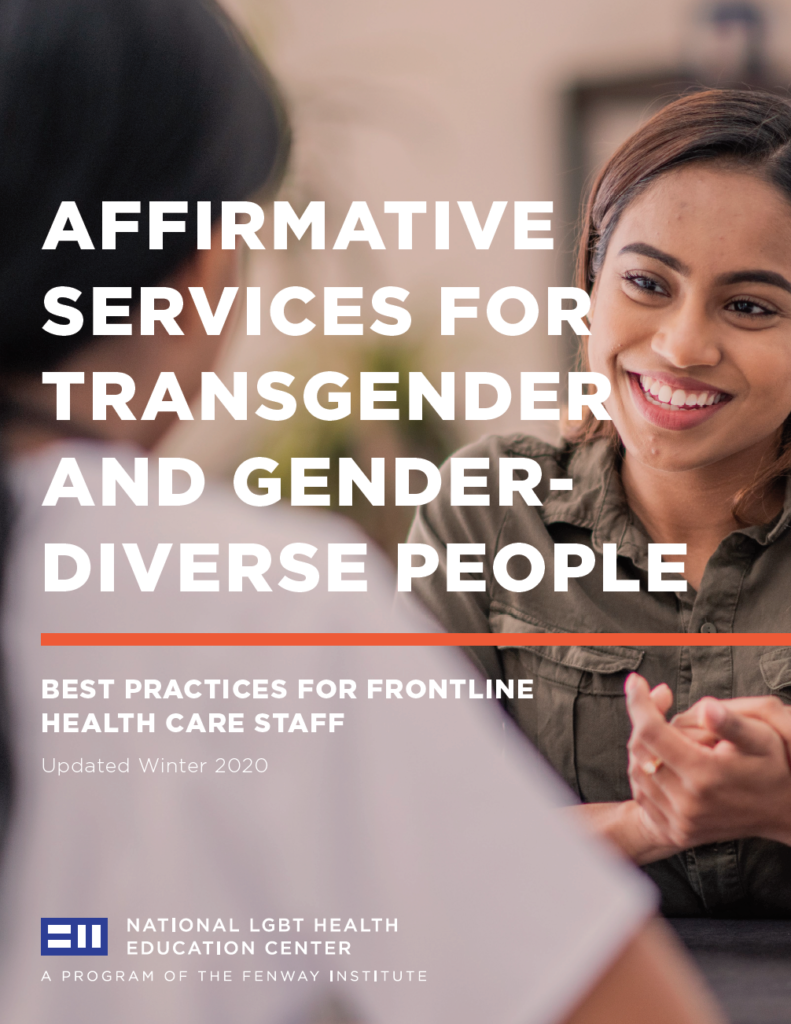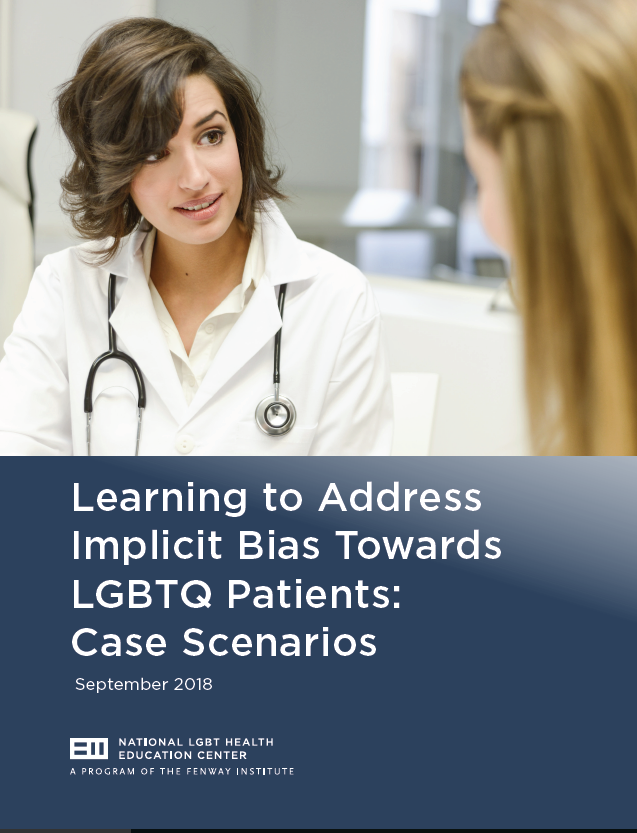This introductory resource of text and videos presents a clear framework for what telehealth is and does.
Telehealth and LGBTQIA+ Communities Toolkit

Telehealth and LGBTQIA+ Communities Toolkit
Since the beginning of the COVID-19 pandemic, telehealth has become an essential way to provide patient care and services with underserved communities, including lesbian, gay, bisexual, transgender, queer, intersex, asexual and all sexually and gender diverse (LGBTQIA+) people. By 2021, 95% of health centers had used telehealth (audio or video) to deliver medical care and 90% of health centers had used telehealth to deliver behavioral health services. The following Telehealth and LGTBQIA+ Communities Toolkit offers a curated list of resources to help begin or expand upon your organization’s telehealth program, with a special focus on supporting LGBTQIA+ communities.
What Is Telehealth?
Telehealth is the use of technology to provide health care services across two or more locations. Telehealth may be delivered through either synchronous methods (when patient care or education is given in real-time) or asynchronous methods (when information is stored electronically and can be accessed by the patient or provider at any time).
Telehealth comes in various modalities:
- Telemedicine: direct patient care or education through video or phone
- mHealth: apps or text messaging on a phone or computer, often used for self-managing care or for communicating with a provider
- Store and forward information: the capturing, storing, and forwarding of health information from one site or provider to another
- Remote patient monitoring: to continuously monitor a patient’s condition from another location
How Telehealth Helps LGBTQIA+ Communities
Most medical schools do not provide sufficient education and training in LGBTQIA+ health care, making it difficult for patients to find and access health care that meets their needs and does not stigmatize their identities.1 By eliminating travel-related barriers, telehealth greatly expands access to providers with expertise in providing culturally affirming and knowledgeable LGBTQIA+ health care.
New innovations in mHealth and remote patient monitoring have the potential to improve health outcomes for LGBTQIA+ patients who experience disparities in certain chronic diseases, such as HIV and diabetes.
How to Use this Toolkit
This toolkit is organized by topic area. You may start at the beginning or jump to a section that is relevant to you. Each section has resources, such as webinars, publications, and websites that are relevant to the topic area.
When you click on a resource box, an explanation and link will pop up on your screen. To return to the toolkit, simply click anywhere on your screen. If you choose to access a resource, it will open in a new tab.
Disclaimer
This toolkit has external resources from reputable organizations with expertise in telehealth and LGBTQIA+ health. While we have linked to these resources, the National LGBTQIA+ Health Education Center is not responsible for any content or advertisements that you may see on the resource page.
This project was supported by the Health Resources and Services Administration (HRSA) of the U.S. Department of Health and Human Services (HHS) under cooperative agreement number U30CS22742, Training and Technical Assistance National Cooperative Agreements (NCAs) for $449,985.00 with 0% of the total NCA project financed with non-federal sources. This information or content and conclusions are those of the author and should not be construed as the official position or policy of, nor should any endorsements be inferred by HRSA, HHS, or the U.S. Government.
Questions and Feedback
Questions or comments about the toolkit? Please email us at [email protected] or use the feedback form below. We will be happy to help you!
Telehealth and LGBTQIA+ Terms and Concepts
If you are new to telehealth, LGBTQIA+ health care, or both, this section of the toolkit is for you. Here you will find resources that explain key telehealth terms and modalities and LGBTQIA+ terms and concepts.
Center for Connected Health Policy—Telehealth 101: What is Telehealth? Terms and Modalities
Center for Connected Health Policy—Telehealth 101: What is Telehealth? Terms and Modalities
In this introductory video from the Center for Connected Health Policy, the presenter defines the different modalities and terms that are used frequently in telehealth and telehealth policy.
LGBTQIA+ Glossary of Terms for Health Care Teams 2020

LGBTQIA+ Glossary of Terms for Health Care Teams 2020
LGBTQIA+ Glossary of Terms for Health Care Teams
Becoming familiar with terms used by lesbian, gay, bisexual, transgender, queer, intersex, asexual, and other sexual and gender minorities (LGBTQIA+) can help you provide patients with the highest quality care. In this glossary, you will find terms relevant to the health care and identities of LGBTQIA+ people.
- Filed under
- Introduction to LGBTQIA+ Health
Foundations of LGBTQIA+ Health, Part 1
Foundations of LGBTQIA+ Health, Part 1
This module provides an overview of LGBTQIA+ health terms, concepts, and disparities. We recommend that all learners start here.
Affirmative Services for Transgender and Gender Diverse People – Best Practices for Frontline Health Care Staff

Affirmative Services for Transgender and Gender Diverse People – Best Practices for Frontline Health Care Staff
This publication provides best practices and guidance for frontline healthcare staff on how to best serve transgender and gender diverse patients. Topics covered include gender affirming language, asking about sexual orientation and gender identity data, asking for name and pronouns used, and more. The publication features a quick-reference sheet that can be removed and posted in a workspace.
Learning to Address Implicit Bias Towards LGBTQ Patients: Case Scenarios

Learning to Address Implicit Bias Towards LGBTQ Patients: Case Scenarios
A primary objective for health care professionals is to establish solid, trusting relationships with patients in order to promote healthier behaviors. As with other minority groups, when working with lesbian, gay, bisexual, transgender, and queer (LGBTQ) patients, it is especially important to build rapport as a way to counteract the exclusion, discrimination, and stigma that many have experienced previously in health care. Despite our best intentions, however, internal --or implicit--biases may affect the way we talk to and behave with patients. For health care professionals, biases can lead to inequitable care, either through biased clinical decisions, or through communicating bias in conversation with patients.
- Filed under
- Introduction to LGBTQIA+ Health
Building and Sustaining Telehealth Programs for Underserved Communities
In this section of the toolkit, you will find resources that provide comprehensive guidance and tools for building and sustaining telehealth programs in health centers and other health care organizations dedicated to increasing access to care for underserved populations.
National Consortium of Telehealth Resource Centers
National Consortium of Telehealth Resource Centers
This consortium of 12 regional and 2 national Telehealth Resource Centers (TRCs) provides comprehensive tools and resources on implementing and sustaining telehealth programs in underserved and rural communities. Each TRC has its own regional or national resources and training opportunities. Consider starting with Telehealth Basics which provides a wide range of resources and information needed to build a telehealth program, including: technology and patient needs assessments; financial planning; laws and regulations; and operating procedures.
Health Center Resource Clearinghouse—Telehealth Learning Bundle
Health Center Resource Clearinghouse—Telehealth Learning Bundle
This bundled set of resources provides information, recommendations, and learning opportunities to support sustainable implementation of telehealth across health centers.
FQHC Telehealth Consortium Telehealth Playbook
FQHC Telehealth Consortium Telehealth Playbook
This how-to guide supports the adoption and sustainability of telehealth at health centers using an equity framework. The guide includes tips for leadership, clinical integration, reimbursement, and more.
Center for Care Innovations Telehealth Improvement Community Fund
Center for Care Innovations Telehealth Improvement Community Fund
This series of webinars focuses on creating telehealth programs for underserved communities.
Department of Health and Human Services—Telehealth Resources for Providers
Department of Health and Human Services—Telehealth Resources for Providers
This website provides telehealth resources for health care providers, such as updates on policies and reimbursement, best practice guides, and resources to help offer telehealth services. They also have resources for patients to learn about how to use telehealth and prepare for a virtual visit.
Health Information Technology, Evaluation, and Quality Center (HITEQ): Telehealth & Telemedicine Resources
Health Information Technology, Evaluation, and Quality Center (HITEQ): Telehealth & Telemedicine Resources
This website offers publications, podcasts, and tools to enhance health center utilization of telehealth. Consider starting with their Highlighted Resources & Events section.
National Telehealth Technology Assessment Resource Center
National Telehealth Technology Assessment Resource Center
This organization offers toolkits to help select appropriate technologies for telehealth programs.
Medicaid & CHIP Telehealth Toolkit
Medicaid & CHIP Telehealth Toolkit
The Medicare telehealth page gives annually updated information on services defined as Medicare telehealth services. The Medicaid & CHIP Telehealth Toolkit provides support to state Medicaid and CHIP agencies in their adoption and implementation of telehealth.
Telehealth for LGBTQIA+ Adults
Just like with physical spaces, it is important for organizations to create culturally affirming virtual spaces for their LGBTQIA+ patients. This section has resources for adapting telehealth programs for LGBTQIA+ communities.
Department of Health and Human Services – Telehealth for LGBTQ+ Patients
Department of Health and Human Services – Telehealth for LGBTQ+ Patients
This website provides tips on providing culturally-affirming telehealth care for LGBTQIA+ people
LGBT Tech
LGBT Tech
This organization offers programs and resources to educate organizations on the unique technology needs of LGBTQIA+ people.
Affirming Health Care for LGBTQIA+ People during the COVID-19 Pandemic
Affirming Health Care for LGBTQIA+ People during the COVID-19 Pandemic
This panel-style presentation features providers in mental health, nursing, and medicine with expertise in LGBTQIA+ health. Each panelist provides their unique perspectives on how the COVID-19 pandemic has affected patient care for LGBTQIA+ people, and what strategies can support access to affirming treatment and referrals.
Telehealth for LGBTQIA+ Youth
Many LGBTQIA+ youth need access to affirming care but do not live in locations with these services. The resources in this section provide examples of how to care for this population through virtual means.
Working with Transgender and Gender Diverse (TGD) Youth during the COVID-19 Pandemic
Working with Transgender and Gender Diverse (TGD) Youth during the COVID-19 Pandemic
This webinar explains the telehealth model developed by Boston Children’s Hospital’s Gender Multispecialty Service to provide gender-affirming medical and behavioral health care for transgender and gender diverse youth.
American Academy of Pediatrics–Unique Considerations When Caring for LGBTQ+ Adolescents via Telehealth
American Academy of Pediatrics–Unique Considerations When Caring for LGBTQ+ Adolescents via Telehealth
In this webinar, a pediatrician and child and adolescent psychiatrist discuss unique considerations for providing care to LGBTQIA+ adolescents via telehealth. Presenters walk through a case example and discuss specific strategies to prepare a practice, preserve confidentiality, and create a welcoming and affirming virtual environment for LGBTQ+ adolescent patients.
Telehealth for Behavioral Health Care of LGBTQIA+ People
The COVID-19 pandemic exacerbated mental health disparities among LGBTQIA+ people. This section of the toolkit helps to address behavioral health needs of LGBTQIA+ people through telehealth.
Behavioral Health Care for LGBTQIA+ Patients during COVID-19
Behavioral Health Care for LGBTQIA+ Patients during COVID-19
This webinar explores how providers can meet the needs of LGBTQIA+ people seeking behavioral health care, including a discussion of telehealth-delivered care and online support programs.
Substance Abuse and Mental Health Services Administration (SAMHSA) —Telehealth for the Treatment of Serious Mental Illness and Substance Use Disorders
Substance Abuse and Mental Health Services Administration (SAMHSA) —Telehealth for the Treatment of Serious Mental Illness and Substance Use Disorders
This guide provides recommendations for using telehealth to provide treatment for serious mental illness and substance use disorders among adults.
Telehealth for HIV Prevention and Care
Telehealth for HIV prevention and care can help to overcome barriers such as time and transportation challenges, HIV stigma, and a shortage of HIV care providers. This section of the toolkit provides resources on how to use telehealth to break down barriers and implement accessible HIV telehealth programs.
Centers for Disease Control and Prevention—Telehealth for HIV Prevention and Care Services
Centers for Disease Control and Prevention—Telehealth for HIV Prevention and Care Services
This collection of evidence-based and cost-effective materials and resources support the implementation and marketing of Telehealth for HIV Prevention and Care Services by health departments, community-based organizations, and health care or other organizations.
Department of Health and Human Services—Telehealth for HIV Care Best Practice Guide [website]
Department of Health and Human Services—Telehealth for HIV Care Best Practice Guide [website]
This guide highlights the needs and procedures for an HIV telehealth program, including HIV diagnosis, treatment, prevention, and response.
Telehealth and Prep HIV Care Outcomes[webinar]
Telehealth and Prep HIV Care Outcomes[webinar]
This webinar discusses research findings and real-world implementation considerations for delivering pre-exposure prophylaxis (PrEP) via telehealth to people at high risk for HIV, including gay/bisexual men and transgender women.
Telehealth Assessment Tools for Health Centers in Underserved Communities
Health centers, rural health care organizations, and other organizations in under-resourced settings need support in accessing affordable, cost-effective telehealth tools. The resources in this section of the toolkit provide telehealth readiness assessments and equity tools.
National Consortium of Telehealth Resource Centers—Assessing Clinical Service Needs: Telehealth Readines [webinar]
National Consortium of Telehealth Resource Centers—Assessing Clinical Service Needs: Telehealth Readines [webinar]
This webinar offers information on preparing to implement telehealth programs in health centers and other health care organizations.
California Telehealth Resource Center—Telehealth Technology Needs and Readiness Assessment [publication]
California Telehealth Resource Center—Telehealth Technology Needs and Readiness Assessment [publication]
This assessment guide helps health care organizations get a complete picture of their telehealth technology needs and readiness before making a purchase.
Health Information Technology, Evaluation, and Quality Center (HITEQ): Telehealth & Telemedicine Resources
Health Information Technology, Evaluation, and Quality Center (HITEQ): Telehealth & Telemedicine Resources
This website offers publications, podcasts, and tools to enhance health center utilization of telehealth. Consider starting with their Highlighted Resources & Events section.

